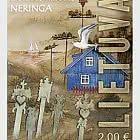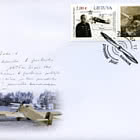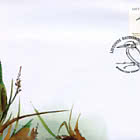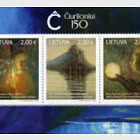2014Europe - The National Musical Instruments - Set
2014 Europe - The National Musical Instruments - Set for only GBP £1.52

- 03.05.2014
- I. Turulytė
- -
- -
- Offset
- -
- 35.5 x 30mm
- 2,45Lt, 2,45Lt
The goat-horn ožragis is a Lithuanian folk instrument made of the goat‘s horn with sound holes and wooden mouthpiece. The traditional goat-horn has 2-6 sound holes. Much strength is required to tootle the goat-horn, and the produced sound is very strong and heard far away. From days of old, the goat-horn has been played by shepherds, hunters, and folk ensembles, and during the battles it has been used to give signals. Nowadays, the goat-horn can be heard in the musical pieces of folk ensembles and modern jazz. The wooden bells skrabalai are made of wood in the shape of trapezium and hanging in a small trapezium shape wooden box. In remote times the wooden bells were common among shepherds - they used to hang them on the cow’s neck in order to locate their place following the bells’ sounds. The wooden bells produce a muted but very well heard sound. Presently they are used by the ensembles of orchestras to have playful tunes shading the whole orchestra. The reed-pipe birbynė is a folk wind-instrumentusually made of goose feather, straw, wood cortex, wood, or beast horn. The reed-pipes are used to imitate sounds, give shepherds’ signals, or play thepolyphonic music sutartinės. Present-day reed-pipes are used in the programmes of the ensembles of orchestras and solo performances. The plucked string musical instrument kanklės has a body made from wood of a deciduous tree, and the cover is made of fir. This instrument has 5-12 strings. The instrument is used to play polyphonic melodies, songs, and dances. Since the 20thcentury, public concerts performed by kanklės are given. Nowadays the sounds produced by kanklės can be heard at international song festivals and in the programmes of the ensembles of orchestras. As a rule, the instrument is used to maintain harmony and rhythm.
Lithuania - Recommended stamp issues
WOPA+ recommended stamp issues
| Avatar - Fire and Ash |
| Issued: 03.12.2025 |
| ›New Zealand |
| 50th Anniversary of the Founding of the 24th November Bar Scout |
| Issued: 24.11.2025 |
| ›Montenegro |
| Krisjanis Valdemars |
| Issued: 02.12.2025 |
| ›Latvia |
| Sign Language - Good |
| Issued: 02.12.2025 |
| ›Bosnia and Herzegovina - Republic of Srpska |
| In Memory of the Fallen and Murdered on October 7, 2023 |
| Issued: 08.10.2025 |
| ›Israel |
| Annual Collection Folder (New York) |
| Issued: 05.12.2025 |
| ›United Nations |
| Year Set |
| Issued: 24.11.2025 |
| ›Isle of Man |
| Shipping in the 17th and 18th Centuries - Peat Shipping |
| Issued: 05.12.2025 |
| ›Netherlands |


























